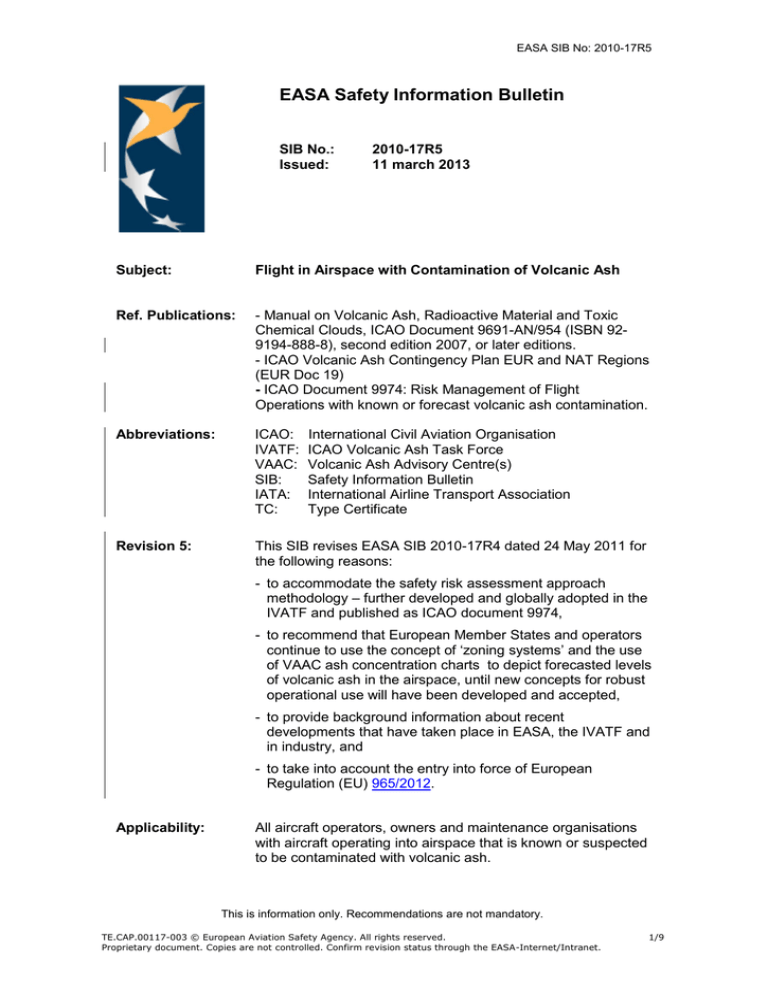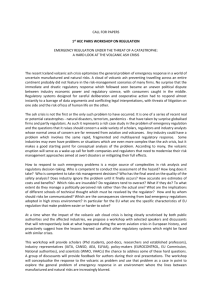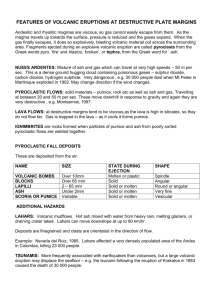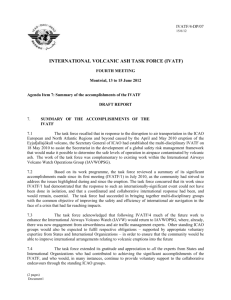
EASA SIB No: 2010-17R5
EASA Safety Information Bulletin
SIB No.:
Issued:
2010-17R5
11 march 2013
Subject:
Flight in Airspace with Contamination of Volcanic Ash
Ref. Publications:
- Manual on Volcanic Ash, Radioactive Material and Toxic
Chemical Clouds, ICAO Document 9691-AN/954 (ISBN 929194-888-8), second edition 2007, or later editions.
- ICAO Volcanic Ash Contingency Plan EUR and NAT Regions
(EUR Doc 19)
- ICAO Document 9974: Risk Management of Flight
Operations with known or forecast volcanic ash contamination.
Abbreviations:
ICAO:
IVATF:
VAAC:
SIB:
IATA:
TC:
Revision 5:
This SIB revises EASA SIB 2010-17R4 dated 24 May 2011 for
the following reasons:
International Civil Aviation Organisation
ICAO Volcanic Ash Task Force
Volcanic Ash Advisory Centre(s)
Safety Information Bulletin
International Airline Transport Association
Type Certificate
- to accommodate the safety risk assessment approach
methodology – further developed and globally adopted in the
IVATF and published as ICAO document 9974,
- to recommend that European Member States and operators
continue to use the concept of ‘zoning systems’ and the use
of VAAC ash concentration charts to depict forecasted levels
of volcanic ash in the airspace, until new concepts for robust
operational use will have been developed and accepted,
- to provide background information about recent
developments that have taken place in EASA, the IVATF and
in industry, and
- to take into account the entry into force of European
Regulation (EU) 965/2012.
Applicability:
All aircraft operators, owners and maintenance organisations
with aircraft operating into airspace that is known or suspected
to be contaminated with volcanic ash.
This is information only. Recommendations are not mandatory.
TE.CAP.00117-003 © European Aviation Safety Agency. All rights reserved.
Proprietary document. Copies are not controlled. Confirm revision status through the EASA-Internet/Intranet.
1/9
EASA SIB No: 2010-17R5
Description:
The recommendations in this revised EASA SIB are based on
the progress that has been made in reviewing and discussing
the volcanic ash airspace contamination threat with the
associations from the manufacturing industry, operators, the
scientific community, the VAAC, the Air Traffic Management
Service Providers and Airworthiness Authorities in the ICAO
IVATF.
For detailed information on the discussions please refer to
Appendix B attached to the SIB.
Further to the progress that has been made in the IVATF, the
EASA continues with rulemaking activities that are aimed at the
following:
- implementing the Volcanic Ash Risk Assessment
methodology in the requirements for Safety Management
Systems for operators of complex aircraft;
- to develop changes to the certification specifications for CS
23, CS 25, CS 27, CS 29 and CS-Engines to require Type
Certificate Holders to describe the susceptibility of their
product to volcanic ash and to provide data to operators to
assist in Volcanic Ash Risk Management;
- to further develop the understanding of the aircraft and
engine tolerance to ingestion of volcanic ash, including the
margins for safe operation, with the aim to prevent the use of
overly conservative assumed aircraft and engine ash
tolerance (or ingestion limits) that could have severe negative
economic and societal effects and could disrupt the aviation
transport system.
This SIB will in the near future be revised in steps, following the
successful ending and implementation of the EASA rulemaking
tasks.
Recommendations: EASA makes the following recommendations:
(1) Avoid operation in visible volcanic ash.
(2) Forecasted presence of volcanic ash should primarily be
presented in the form of a zoning system that depicts
areas of low, medium and high concentrations in 3 altitude
bands.
EASA continues to recommend that ash concentration
charts provided by the London VAAC and Toulouse VAAC
should, for operations in European airspace, identify the
three zones as described in the ICAO Volcanic Ash
Contingency Plan EUR and NAT Regions (EUR Doc 019),
being:
- Area of Low Contamination (to be displayed in Cyan): an
airspace of defined dimensions where volcanic ash may be
encountered at concentrations greater than 0,2 x 10E-03
grams/m3, but less than or equal to 2 x 10 E-03 grams/m3.
This is information only. Recommendations are not mandatory.
TE.CAP.00117-003 © European Aviation Safety Agency. All rights reserved.
Proprietary document. Copies are not controlled. Confirm revision status through the EASA-Internet/Intranet.
2/9
EASA SIB No: 2010-17R5
- Area of Medium Contamination (to be displayed in Grey):
an airspace of defined dimensions where volcanic ash may
be encountered at concentrations greater than 2 x 10 E-03
grams/m3, but less than 4 x 10 E-03 grams/m3.
- Area of High Contamination (to be displayed in Red): an
airspace of defined dimensions where volcanic ash may be
encountered at concentrations equal to or greater than 4 x
10 E-03 grams/m3, where no ash concentration guidance
is available.
(3) When ash is forecast to be present within European
airspace, it is recommended that an operator conduct flight
operations in areas with Medium or High Forecast Ash
Contamination, only if they have secured the agreement of
the National Aviation Authority supervising their operations
to their safety risk assessment for such operations.
(i)
Pending the end of the EASA rulemaking task on
Volcanic Ash Safety Risk Management, the Safety
Risk Assessment should be developed and agreed in
accordance with the guidance provided in ICAO
Document 9974: ‘Risk management of flight
Operations with known or forecast volcanic ash
contamination’. The ICAO Document 9974 may be
adopted at a version ‘best suited to the operators
needs’.
(ii) EASA draws the attention of operators to the specific
advice of TC holders to avoid flight into visible ash at
all times, regardless of the forecast conditions.
(iii) For the benefit of the aviation community and the Air
Traffic Management Service Providers, EASA
requests the operators to report the acceptance of the
Volcanic Ash Safety Risk Assessment to EASA
(volcano@easa.europa.eu).
EASA will keep a database of accepted VA SRA as a
living document, for operational use in time of
eruptions and volcanic ash exercises. Access to this
information will be shared only with Member State
institutions authorised by EASA to have such access.
(iv) It is recommended that Member States will not
normally close airspace that is forecast to contain ash
contamination, except for conditions under (v), in order
to allow the safety assurance process vested in the
Safety Risk Assessment approach to have effect.
Airspace closure should be an action of last resort
contemplated only in situations in which the Safety
Risk Assessment approach can no longer be relied
upon to secure safe operations; no such situations are
presently foreseen.
(v) Member States may decide to close airspace in the
immediate vicinity of a volcano where volcanic ashes
and gasses form a direct threat for the safety of flight.
This is information only. Recommendations are not mandatory.
TE.CAP.00117-003 © European Aviation Safety Agency. All rights reserved.
Proprietary document. Copies are not controlled. Confirm revision status through the EASA-Internet/Intranet.
3/9
EASA SIB No: 2010-17R5
(4) In accordance with Article 11.1 of the Basic Regulation,
European Member States shall, without further technical
requirements or evaluation, recognise certificates issued in
accordance with Regulation (EU) 965/2012. This
recognition includes the Volcanic Ash Safety Risk
Assessment as part of the Safety Management System
that has been accepted by the National Competent
Authority of the Operator. It is recommended that
European Member States mutually accept the Volcanic
Ash Safety Risk Assessments accepted by Aviation
Authorities from non-European Member States provided
that those VA SRA are based on a suitable adopted
version of the ICAO Document 9974.
(5) In close vicinity to volcanoes that are observed on a 24
hour, 7 days a week basis, and where such equipment is
present to accurately observe the movement of the plume
and volcanic ash, local airport and air traffic management
procedures may exist to guide the aircraft outside airspace
where volcanic ash is present. The short range continuous
observation of the volcanic ash may produce an equivalent
result as the ash dispersion modelling and concentrations
charts that are in principle for the longer distances from the
volcano. Such local procedures should be acceptable to
the National Competent Authority.
(6) When the aircraft and engine TC-Holders have not
developed instructions for continued airworthiness for
operation in airspace with a low contamination of volcanic
ash, EASA recommends the inspections to be performed
as listed in Appendix A, attached to this SIB.
(7) EASA requests the feedback from EU Member States and
associated countries, the airspace management
organisations and operators for improvement of this SIB,
be informed of any difficulties that are being experienced
on implementing the safety recommendations contained in
this SIB. The SIB will be revised as necessary.
Contacts:
For further information contact the Airworthiness Directives,
Safety Management & Research Section, Certification
Directorate, EASA; E-mail: ADs@easa.europa.eu.
Reports can be submitted to EASA by E-mail:
volcano@easa.europa.eu.
To obtain a copy of ICAO Documents, contact the ICAO
Customer Services Unit,
telephone +1 514-954-8022, facsimile +1 514-954-6769,
or by e-mail request to sales@icao.int.
Websites:
Additional information on the subject addressed by this SIB can
be found on the following websites:
www.icao.int
www.easa.europa.eu
This is information only. Recommendations are not mandatory.
TE.CAP.00117-003 © European Aviation Safety Agency. All rights reserved.
Proprietary document. Copies are not controlled. Confirm revision status through the EASA-Internet/Intranet.
4/9
EASA SIB No: 2010-17R5
Appendix A - General advice for aircraft (all turbine and piston powered aircraft,
including rotorcraft) maintenance inspections when operating in airspace with a
low contamination of volcanic ash
(1) The following is provided as advice to operators if their aircraft and/or engine TC
Holders have not developed instructions for continued airworthiness for
operation in airspace with a low contamination of volcanic ash.
(a) Accomplish daily inspections when operating in an area of low volcanic ash
airspace contamination, to detect any erosion, accumulation of volcanic ash,
or any aircraft- and/or engine damage or system degradation. Turbine
engines as well as piston engines operation can be adversely affected by
volcanic ash on the ground or in the air.
The inspections should include the following:
-
wing leading edges
navigation and landing lights, radomes
landing gear
horizontal stabiliser
all extruding structure
pitot tubes and static ports
windows and windshields
engine inlets and nacelles (turbine), induction air filter (piston)
engine cooling system components
engine compressor and turbines
engine oil systems
fuel tank venting system
rotor blades
ventilation and pressurization systems (e.g., the air cycle machines, ozone
converter, recirculation fans, HEPA filters, etc.)
- smoke detectors (e.g., detectors located in the cargo compartment, lavatory,
electrical equipment bay, remote crew rest areas, etc.)
Based on the findings of the above inspections, more detailed inspections (such
as boroscope inspections of the engine, oil analysis, inspection of filters,
cleaning of parts) may be necessary.
Unless specific instructions have already been provided by aircraft and engine
TC holders to be applied after encountering a volcanic ash, the above
inspections should also be performed after each flight, whenever the following
phenomena are observed or detected or experienced during flight
-
Acrid odours similar to electrical smoke
Rapid onset of engine problems
St. Elmo’s fire
Bright white/orange glow appearing at the engine inlets
Dust in the cockpit or cabin
Sudden (unexpected) outside darkness
Airspeed fluctuations
Landings lights casting sharp, distinctly visible beam
(b) Protect and cover aircraft that are parked in areas that may be contaminated
by the fall out or settling of volcanic ash in accordance with the aircraft- and
This is information only. Recommendations are not mandatory.
TE.CAP.00117-003 © European Aviation Safety Agency. All rights reserved.
Proprietary document. Copies are not controlled. Confirm revision status through the EASA-Internet/Intranet.
5/9
EASA SIB No: 2010-17R5
engine TC-holder’s advice where possible. Any volcanic ash residues must
be removed prior to operations and following the TC Holder’s
recommendations when available.
(2) Report any encounter with volcanic ash, or any other relevant maintenance and
airworthiness related findings, to the engine and aircraft TC holders, the State of
Registry of the aircraft and to the National Aviation Authority of the State through
which the flight was conducted.
In addition, operators should report to EASA any serious airworthiness- and
maintenance related findings after encounters with volcanic ash, for EASA to
produce a synthesis of findings and trends resulting from these inspections, so
that improvements could be brought to the procedures recommended by this
SIB.
This is information only. Recommendations are not mandatory.
TE.CAP.00117-003 © European Aviation Safety Agency. All rights reserved.
Proprietary document. Copies are not controlled. Confirm revision status through the EASA-Internet/Intranet.
6/9
EASA SIB No: 2010-17R5
Appendix B – The ICAO Volcanic ash Task Force and industry initiatives
In June 2012, the ICAO IVATF held its fourth and final meeting. The IVATF was
created in 2010 to review the global aviation standards that are applied when
airspace is forecasted to be contaminated with volcanic ash. In 2010, EASA and the
European Commission committed – besides EASA’s own defined Volcanic Ash work
programme - to work with ICAO on reviewing and developing improved global
standards for flight operations with known or forecast volcanic ash contamination. In
a multi-disciplinary approach, the ICAO Task Force developed a significant further
understanding of the many aspects associated with the effects of volcanic ashes on
the aviation transport system. With this improved understanding, it was hoped that
the global approach to managing flight safety when ash is a potential hazard could be
improved in order to assure safety whilst minimising flight disruption. The areas of
expert review and development of guidance material were among aircraft
airworthiness and operational aspects, also the aspects associated with air traffic
management, meteorological forecasting, volcanology and technology to detect
volcanic ash in the atmosphere. Many interdependencies between these expert
fields existed and needed to be reviewed to realise the areas for improvements for
the aviation transport system sector as a whole. Improved and new ICAO guidance
material was proposed with regard to global aspects of flight operations with known
or forecast volcanic ash contamination.
The aviation manufacturing industry and associations, VAAC and the operators
associations (IATA) developed initiatives to define the Best Practices for global
operational use. A new concept for Volcanic Ash dispersion forecasting and
presentation (being a single line that delineates areas where visible ash can be
expected to be present with low, medium or levels of confidence in the forecasting
accuracy) was initially developed in the Volcanic Ash Best Practices Workshop. The
concept looks promising as a way to standardise VAAC products globally, however
further development of this concept is necessary in order to generate a robust
operational safety assurance approach; ICAO is to task its International Airways
Volcanic Watch Operations Group (IAVWOPSG) accordingly. ICAO intends that this
Group be re-launched early in 2013 with new terms of reference and a wider
membership.
Concepts of avoidance of volcanic ash as planning and/or tactical means:
In considering flight in airspace with a forecast contamination of volcanic ash which
may be hazardous to aviation, manufacturers have determined that aircraft engines
are by far the most susceptible aircraft parts to volcanic ash. The accepted guidance
from these manufacturers is to avoid flight into “visible ash”.
Volcanic ash may be present close to an erupting volcano, where the ash plume can
be readily visible to the human eye in daylight conditions. It can also be present in
the form of very fine ash particles - volcanic dust – that travels at very long distances
(>1 000 km) from the volcano. These more distant ash clouds typically exist in thin
layers and at very low concentrations.
Close to the volcanic source, the avoidance of a well-defined and highly visible ash
plume is a useful tactical means of assuring safety of flight. Further from the source,
however, there are limitations to the usefulness of “visible ash” as a safety assurance
technique.
This is information only. Recommendations are not mandatory.
TE.CAP.00117-003 © European Aviation Safety Agency. All rights reserved.
Proprietary document. Copies are not controlled. Confirm revision status through the EASA-Internet/Intranet.
7/9
EASA SIB No: 2010-17R5
Volcanic ash will generally not be visible to the crew under Instrument Meteorological
Conditions or at night. Also, even under good visibility conditions, ash and dust
clouds that travel over long distances can be very difficult to distinguish from normal
clouds, smoke, haze etc and can, therefore, be difficult to avoid.
These limitations in the usefulness of visible ash have led to exploration of the
“discernible ash”, detected by using remote sensing techniques, when available.
Using technology to detect, and so help to forecast how the volcanic ash will spread
in the airspace, is another concept which might prove useful as a planning means to
avoid encounters with volcanic ash.
However, “discernible ash” has limited tactical usefulness either because of
limitations in data gathering (e.g. obscuration of remote sensing imagery) or in
timeliness in acquiring, analysing and utilizing the data. The best avoidance of ash is
based on an intelligent combination of concepts that use the ‘human eye’, remote
sensing technology, human communication (collaborative decision making) and
medium to long range forecast models to predict the presence of volcanic ash.
In the future, given the frailties of visible ash (night, IMC, ash misidentification by day)
and of discernible ash (availability of data, limited tactical usefulness), further
improvements and capabilities are being progressed. These improvements, some
still in their infancy, focus on better forecasting the presence of ash, better
understanding what ash exposure represents a hazard (in terms of ash concentration
and duration of exposure) and capability on-board aircraft to alert crews to hazardous
ash concentrations on the aircraft’s intended flight path. These initiatives are very
welcome.
Safety Risk Assessment: more responsibility for the operator:
This SIB accommodates the safety risk assessment approach methodology as
developed and globally accepted under the ICAO IVATF. The published version is
ICAO document 9974 ‘Risk management of flight operations in areas known or
forecasted to be affected by volcanic ash’.
The document sets out the principles to be applied to help operators to assess if
flights in airspace contaminated with volcanic ash can be executed safely because
the risks are controlled and mitigated.
The IVATF recommended that States adopt ICAO Document 9974 at a version best
suited to their needs.
This unique guidance for safety risk assessment has been evaluated and tested
successfully. It forms a fundamental part of a safety assurance system whereby the
operators can demonstrate to the satisfaction of the National Aviation Authority that
they have the means to be able to manage and control their risks when volcanic ash
may represent a hazard to safe flight operations.
Airworthiness effects, continued airworthiness:
Flights in airspace with a low contamination with volcanic ash, where no imminent
threat to the safety of the aircraft exists, might have medium and long term
consequences for the airworthiness of aircraft.
This is information only. Recommendations are not mandatory.
TE.CAP.00117-003 © European Aviation Safety Agency. All rights reserved.
Proprietary document. Copies are not controlled. Confirm revision status through the EASA-Internet/Intranet.
8/9
EASA SIB No: 2010-17R5
With regard to flights in airspace with a low volcanic ash contamination, it is essential
that priority continues to be given to maintaining the continuing airworthiness of
aircraft in order to support the continuation of safe operations.
Aircraft and Engine TC-Holders have been requested by EASA to develop and
improve the instructions necessary for continued safe flight, such as specific pre- and
post-flight inspections, and those for continued airworthiness, taking into account the
effects of operation of aircraft in airspace with low contamination volcanic ash.
Those instructions are also requested for aircraft parked in areas that may be
contaminated by the fall out and settling of volcanic ash. Special emphasis is
requested for those systems that are most sensitive to any exposure to volcanic ash.
The sensitive systems are known to be, but may not be limited to, engine
compressors and turbines, engine oil systems, aircraft pitot- and air data systems,
aircraft environmental control systems, and those aircraft systems that provide
cooling air for computer systems installed on the aircraft.
Prediction of the ash dispersion in the airspace - volcanic ash concentration
charts and ‘best practice charts under development’:
In addition to the charts required by international regulations produced by the London
VAAC, the U.K. meteorological office supporting the London VAAC produces
volcanic ash concentration charts that depict predicted areas of volcanic ash
contamination. These charts show forecast ash concentration levels in 3 altitude
bands and in 3 different zones. This information is produced to assist operators in
operational planning and to facilitate coherent and consistent decision-making by
national authorities with regards to their airspace management and safety assurance
duties.
Given the particular needs of European airspace in respect of managing a high traffic
density, it is essential that the best available volcanic ash dispersion forecasts
information is provided that allows for robust operational use. Given that the
IAVWOPSG work on the concept of a safety assurance approach based on “visible”
and “discernible” ash criteria is not yet ready for operational use, EASA recommends
the continued use of meteorological ash concentration charts for operations in
European airspace.
EASA does not object to the future concept that is to be developed by IAVWOPSG
which is expected to result in volcanic ash prediction charts comprising a single line
for visible ash together with three confidence levels.
This is information only. Recommendations are not mandatory.
TE.CAP.00117-003 © European Aviation Safety Agency. All rights reserved.
Proprietary document. Copies are not controlled. Confirm revision status through the EASA-Internet/Intranet.
9/9





